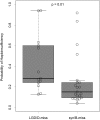Increased burden of de novo predicted deleterious variants in complex congenital diaphragmatic hernia
- PMID: 26034137
- PMCID: PMC4512631
- DOI: 10.1093/hmg/ddv196
Increased burden of de novo predicted deleterious variants in complex congenital diaphragmatic hernia
Abstract
Congenital diaphragmatic hernia (CDH) is a serious birth defect that accounts for 8% of all major birth anomalies. Approximately 40% of cases occur in association with other anomalies. As sporadic complex CDH likely has a significant impact on reproductive fitness, we hypothesized that de novo variants would account for the etiology in a significant fraction of cases. We performed exome sequencing in 39 CDH trios and compared the frequency of de novo variants with 787 unaffected controls from the Simons Simplex Collection. We found no significant difference in overall frequency of de novo variants between cases and controls. However, among genes that are highly expressed during diaphragm development, there was a significant burden of likely gene disrupting (LGD) and predicted deleterious missense variants in cases (fold enrichment = 3.2, P-value = 0.003), and these genes are more likely to be haploinsufficient (P-value = 0.01) than the ones with benign missense or synonymous de novo variants in cases. After accounting for the frequency of de novo variants in the control population, we estimate that 15% of sporadic complex CDH patients are attributable to de novo LGD or deleterious missense variants. We identified several genes with predicted deleterious de novo variants that fall into common categories of genes related to transcription factors and cell migration that we believe are related to the pathogenesis of CDH. These data provide supportive evidence for novel genes in the pathogenesis of CDH associated with other anomalies and suggest that de novo variants play a significant role in complex CDH cases.
© The Author 2015. Published by Oxford University Press. All rights reserved. For Permissions, please email: journals.permissions@oup.com.
Figures



References
-
- Doyle N.M., Lally K.P. (2004) The CDH Study Group and advances in the clinical care of the patient with congenital diaphragmatic hernia. Semin. Perinatol., 28, 174–184. - PubMed
-
- Pober B.R., Russell M.K., Ackerman K.G. (1993) Congenital diaphragmatic hernia overview. In Pagon R.A., Adam M.P., Ardinger H.H., Wallace S.E., Amemiya A., Bean L.J.H., Bird T.D., Dolan C.R., Fong C.T., Smith R.J.H., Stephens K. (eds), In GeneReviews(R). Seattle, WA: Available from: http://www.ncbi.nlm.nih.gov/books/NBK1359/ (date last accessed, 1 June 2015). - PubMed
-
- Langham M.R., Jr, Kays D.W., Ledbetter D.J., Frentzen B., Sanford L.L., Richards D.S. (1996) Congenital diaphragmatic hernia. Epidemiology and outcome. Clin. Perinatol., 23, 671–688. - PubMed
-
- Downard C.D., Jaksic T., Garza J.J., Dzakovic A., Nemes L., Jennings R.W., Wilson J.M. (2003) Analysis of an improved survival rate for congenital diaphragmatic hernia. J. Pediatr. Surg., 38, 729–732. - PubMed
Publication types
MeSH terms
Grants and funding
LinkOut - more resources
Full Text Sources
Other Literature Sources
Medical
Molecular Biology Databases
Research Materials

